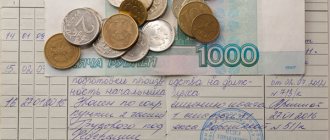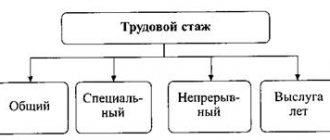Compensation for unused vacation upon dismissal in 2020 is calculated based on the number of days not taken off and the amount of average daily earnings. We will consider the nuances of the calculation in the article. Many people are asking whether compensation has changed during the coronavirus period. Let's answer this question.
Changes in the calculation of compensation upon dismissal due to coronavirus
Accountants must calculate vacation pay and vacation compensation in 2020, taking into account the changes. The average earnings do not take into account non-working days according to the Presidential Decree, says the letter of the Ministry of Labor dated May 18, 2020 No. 14-1/B-585. This means that accountants must calculate average earnings for the year without taking into account “quarantine” non-working days and amounts accrued for these days. Now accounting programs are reconfiguring their algorithms to suit the new order.
Average earnings are taken for the year that precedes the month of payment of vacation pay. For example, for vacation pay for June 2021, the period from June 2021 to May 2021 is taken. It is not difficult to understand that now the entire remaining 2021 and another half of 2021 will have to be counted taking into account the exceptions of non-working days in March-May.
You may be interested in: sample list of transferred documents 2020
Where is the employer’s obligation to compensate for unpaid vacation upon dismissal described?
Article 127 of the Labor Code of the Russian Federation obliges the employer, when dismissing an employee, to pay him money if such an employee has unused rest periods.
The same article talks about the employee’s right, instead of payments before dismissal, to take unused days off. There are some nuances:
- if an employee worked under an open-ended contract and quits of his own free will, then when going on vacation with subsequent dismissal, he can withdraw his application before the end of the vacation;
- If an employee worked under a fixed-term employment contract, then when he goes on vacation before dismissal, the record of his dismissal may be already in the field of the end date of the fixed-term contract.
Letter of Rostrud dated July 2, 2009 No. 1917-6-1 indicates that the payment is made regardless of the reason for dismissal. It is also necessary to pay money upon dismissal due to unsatisfactory results during the probationary period.
Is temporary workers entitled to compensation upon dismissal against unused vacation?
Important! If a temporary employee has worked for the company for 6 months or more, the employer is obliged to provide for him a full list of payments (including compensation) that are due to permanent employees upon dismissal from work.
Thus, together with the remaining wages and, in some cases, severance pay, a temporary employee upon leaving work is paid compensation for unused vacation (vacation pay that was not received due to the fact that the employee never went on annual paid leave).
In order to correctly calculate the payments due to a temporary employee, the accounting department must have the following information:
- The total length of service of the subordinate in the company in which he currently works (the procedure and rules for calculating the length of service giving the right to leave are given in parts 1 and 2 of Article 121 of the Labor Code of the Russian Federation).
- The number and duration of periods that are excluded from the total length of service at the company (if any).
- The number of days that are not included in the total length of service, but must be taken into account for the purpose of providing paid annual leave.
- The total number of rest days that have “accumulated” during the current period that have not been used by the temporary worker.
- The number of days of the next vacation that were used by temporary staff “in advance” (before the right to rest arises) - payment for such days should be excluded from the final amount of compensation for unused vacation.
When calculating the amount of compensation for unused days of annual paid leave, the following points are taken into account:
| No. | Information that must be taken into account when calculating compensation | Additional information |
| 1 | Number of vacation days per 1 month of work at the enterprise | The company's permanent employees earn 2.33 days of annual leave for every month they work for the company. As for temporary employees, the number of days of paid leave per 30 days worked depends on the total duration of work at the enterprise:
○ it will be counted as fully worked if the employee appeared at the workplace for 15 or more days (in February - 14 days) of this month (worked for more than half the month); ○ it will not be taken into account at all if the employee worked less than 15 days.
|
| 2 | Annual leave days spent | When calculating the number of months worked at the company for the purpose of paying compensation for unused vacation, non-calendar months are taken into account - the countdown begins from the moment the temporary employee is hired. If an employee managed to use several days of his allotted vacation, the “cost” of these days is excluded from the compensation amount. |
| 3 | Inclusion in the total length of service at the enterprise of periods during which no activity was carried out, but which must be taken into account | The length of service must include certain periods of time during which the temporary employee was not in the workplace. These periods include those during which the employee received average daily earnings: ● annual leave, ● weekends, ● generally recognized holidays, ● production downtime through no fault of the employee, ● forced absences due to the fault of the employer, ● extraordinary unpaid leaves (no more than 14 days per 1 working year). |
How to calculate the number of days for payment
The number of days of unused vacation is the difference between the days of vacation allotted for the entire period of work and the days of vacation actually used.
When calculating the number of days for which compensation is due, one should be guided by clause 28 of the Rules on regular and additional leaves, approved by the People's Commissariat of Labor of the USSR on April 30, 1930 No. 169.
The following rules apply:
- paid for a full year of work if the employee got a job less than a year ago but worked for more than 11 months;
- paid for a full working year if the employee has worked for more than 5.5, but less than 11 months, and is dismissed due to the liquidation of the employer, staff reduction or conscription;
- for the second and subsequent working years it is paid in proportion to the time worked (letter of Rostrud dated 03/04/2013 No. 164-6-1);
The previously mentioned letter of Rostrud dated 07/02/2009 No. 1917-6-1 says that when calculating the period for which money must be paid, the calculation is made in proportion to the months worked in the working year (if working for more than a year). In this case, in case of an incomplete month, a period of less than half a month is excluded from the calculation, and a period of more than half a month is considered as a whole month.
Rostrud also described in detail the definition of the worked period in a letter dated October 28, 2016 No. 14-1/B-1074.
Please note that in the context of these calculations, when using the term “worked month”, we mean not a calendar month, but a working month. That is, this period begins not from the first day, but from the date of hiring. This follows from the provisions of Art. 14 Labor Code of the Russian Federation.
For each month worked, the employee is entitled to 2.33 days of vacation (with the usual duration of the main annual paid one). This conclusion follows from the letter of Rostrud dated October 31, 2008 No. 5921-TZ.
Please note that you cannot round down the number of unused days. This is confirmed by the Ministry of Health and Social Development of Russia in letter dated December 7, 2005 No. 4334-17.
As for fixed-term employment contracts lasting less than two months, when determining the number of days of compensation, Art. 291 Labor Code of the Russian Federation. She says that for each month of work under such an agreement, two calendar days of vacation are provided.
In what cases can I get it?
The Labor Code of the Russian Federation provides for a certain number of large groups of grounds for dismissal:
- the employee’s own desire;
- employer initiative;
- layoffs of employees or liquidation of an organization are also grounds for dismissal, where the initiator is the employer, but they always stand apart due to the peculiarities of the procedures;
- for reasons beyond the control of the parties, for example, if the employee’s health has deteriorated and he objectively cannot work as before.
In each of these cases, the resigning employee of the organization has the right to receive compensation for unused vacation. Provided that there are days off, of course.
In fact, this compensation is very similar to wages (read about the specifics of paying wages upon dismissal here, and from this article you will learn how to appeal illegal actions of management if you have not paid wages upon dismissal). Only the salary is paid for the performance of a certain labor function, and compensation, such as the calculation of vacation pay, is for the days that an employee of the organization must be at home, being confident that he will retain his job.
This is not a bonus, not an incentive payment, which can be deprived if an employee, for example, was caught in a gross violation of labor discipline.
Attention! Compensation for vacation, as well as the vacation itself, are the main guarantees in the field of labor relations.
For details on whether taxes and contributions are charged on compensation payments, as well as how to reflect the code and type of income in 6-NDFL and 2-NDFL, read our material.
According to the Rules approved by the People's Commissariat of Labor of the USSR No. 169 in 1930, Letter of Rostrud No. 1519-6-1 of 2012, if dismissal occurs due to the liquidation of the organization or reduction of employees, as well as, for some reasons not dependent on the will of the parties, and the employee has worked in the organization for less than a year, but more than 5.5 months, then he has the right to demand compensation for a full year.
How is the amount for unused vacation calculated?
To determine the amount for unused vacation, you must multiply the number of unused days by your average daily earnings.
When calculating the amount of average daily earnings, it is necessary to refer to the Decree of the Government of the Russian Federation dated December 24, 2007 No. 922 “Regulations on the specifics of the procedure for calculating average wages” (hereinafter referred to as the Regulations).
Look at the algorithm for calculating the amount of average daily earnings:
- First of all, you should understand what period is considered to be the settlement period. Possible options: 12 full months preceding the month of dismissal. That is, if an employee quits in October 2021, the calculation period will be the year from October 1, 2021 to September 30, 2020.
- The entire period of work with less than a year of service with the employer. That is, if an employee started working in April 2021 and leaves in October 2021, then the calculation period will be the period from the date of admission in April to September 30, 2021.
- 12 full months (or part of this period) before going on maternity leave, if the employee quits immediately after leaving maternity leave or parental leave.
- Current month, if an employee who has worked for less than a month leaves.
- salary in monetary and non-monetary form based on salary, piece rates, tariff rates, percentage of revenue, etc.;
- vacations and other cases of breaks in work while maintaining average earnings;
The payments also do not take into account financial assistance, compensation for transportation costs, tuition fees and other social payments (clause 3 of the Regulations).
- Determine the length of the billing period in days. For each fully worked calendar month, you should take the average monthly number of days - 29.3 (Article 139 of the Labor Code of the Russian Federation). In case of an incompletely worked month, including due to vacations, sick leave and other breaks, the number of days is calculated in proportion to the figure 29.3 (clause 10 of the Regulations).
- Divide all accruals by the length of the billing period in days.
To determine the amount for unused vacation, you should multiply the average daily earnings by the number of unused days.
Please note that there are nuances in calculating average daily earnings related to the indexation of such earnings when salaries or tariff rates are increased throughout the enterprise or structural division. In addition, average daily earnings are calculated differently if the employer provides vacation in working days.
In the next section we will look at an example calculation.
Calculation example
Deputy Chief Engineer of Alternative LLC I.G. Petrov was hired on October 13, 2021. In 2021, he wrote a letter of resignation of his own free will. The date of dismissal according to his statement is June 7, 2021. During the entire period of work, Petrov I.G. was on vacation twice: 14 days from August 6 to August 19, 2021; 21 days from April 1 to April 21, 2021. The company has established the usual duration of main leave - 28 calendar days. There are no additional holidays provided. The salary of the deputy chief engineer of Alternative LLC did not change and from the very beginning of work was 45,000 rubles. No additional payments were awarded. Let's calculate how many total vacation days an employee is entitled to for the entire period of work: for the first working year from October 13, 2021 to October 12, 2021 - 28 days; for the second not fully worked working year from October 13, 2018 to June 7, 2021, i.e. 7 full working months and one incomplete, but lasting more than half - (7 + 1) * 2.33 = 18.64. Accordingly, compensation must be paid for the following number of days: (28 + 18.64) – 14 – 21 = 11.64 To calculate the average daily earnings, the period from June 2021 to May 2020 is taken. This billing period included 2 vacations. The amount of vacation pay must be excluded from the payments taken into account, and the vacation period must be excluded from the duration of the billing period. The amount of accrued salary for the days worked in August 2018 was 45,000 / 23 * 13 = 25,434.78 rubles. The period worked accounted for 16.07 calendar days ((31 – 14) / 31 * 29.3). The amount of accrued salary for the days worked in April 2020 was 45,000 / 22 * 7 = 14,318.18 rubles. The period worked accounted for 8.79 calendar days ((30 – 21) / 30 * 29.3). The remaining months of the pay period are included in full - both the entire salary is accepted in full and the average monthly number of calendar days is 29.3. The average daily earnings for calculating compensation for unused vacation of I. G. Petrov is equal to: (45,000 * 10 + 25,434.78 + 14,318.18) / (29.3 * 10 + 16.07 + 8.79) = 478,752 .96 / 317.86 = 1,534.49 Compensation for unused vacation of I. G. Petrov is: 1,534.49 * 11.64 = 17,861.46 From the amount, personal income tax is withheld in the amount of 2,322.
What is vacation pay?
The legislation of the Russian Federation states: the employer pays for the employee’s stay on vacation by providing him with monetary allowance (the so-called vacation pay). The principle of calculating vacation pay takes into account the average daily earnings. The average daily earnings of an employee are calculated in several ways (taking into account the conditions for going on vacation), which is calculated in several ways, applicable depending on certain conditions for going on vacation. There are options for calculating vacation pay:
- The employee worked the entire required period (year), after which he exercised the right to a 28-day rest.
- The employee has worked for less than a full year and wishes to go on vacation for the period prescribed by law.
- The specialist decided to quit and receive compensation for unused vacation (he was not on vacation).
To correctly calculate vacation pay, three indicators are calculated in each case:
- billing period
- average daily earnings
- amount to be issued
.
When calculating salaries for vacationers in 2021, the accountant uses Regulation No. 922 of December 24, 2007, as the main regulatory document. () Regulation No. 922 examines in detail all possible conditions for calculating vacation pay. But in order to understand the system (methodology) for calculating vacation pay adopted in the Russian Federation, typical examples are sufficient.
What to do if an employee takes his vacation in advance?
Situations when an employee takes his vacation in advance occur quite often. The vacation schedule is formed based on the fact that in his working year the employee takes off all 28 or more days allotted to him.
Article 137 of the Labor Code of the Russian Federation includes the case of vacation taken in advance in possible deductions from wages to compensate for the employer’s expenses. There are exceptions. It is impossible to withhold the amount of vacation pay for unworked days in the event of such dismissals:
- in connection with the refusal to transfer to another job for medical reasons (clause 8, part 1, article 77 of the Labor Code of the Russian Federation);
- in connection with the liquidation of an enterprise (deregistration of individual entrepreneurs) (clause 1, part 1, article 81 of the Labor Code of the Russian Federation);
- in connection with the reduction (clause 2, part 1, article 81 of the Labor Code of the Russian Federation);
- in connection with the dismissal of the manager, his deputies or the chief accountant due to a change in the owner of the organization (clause 4, part 1, article 81 of the Labor Code of the Russian Federation);
- in connection with conscription into the army (clause 1 of article 83 of the Labor Code of the Russian Federation);
- in connection with the reinstatement of the predecessor who held the position of the dismissed person (clause 2 of Article 83 of the Labor Code of the Russian Federation);
- in connection with a medical report about the inability to hold a position (clause 5 of Article 83 of the Labor Code of the Russian Federation);
- in connection with death (clause 6 of article 83 of the Labor Code of the Russian Federation);
- due to the occurrence of emergency circumstances (clause 7 of article 83 of the Labor Code of the Russian Federation).
Please note that if the accrued wages before dismissal are not enough to pay off the debt for unearned vacation, the employee cannot be required to return this amount; the return can only be voluntary. This is indicated by Part 4 of Art. 137 Labor Code of the Russian Federation. Moreover, if more than 20% of the salary is collected from an employee without his consent, claims may arise against the employer. After all, according to the norms prescribed in Art. 138 of the Labor Code of the Russian Federation is exactly such a limit on deductions from wages.
Cases when compensation for unused vacation is possible without dismissal
Article 126 of the Labor Code of the Russian Federation describes cases when it is permissible to pay money for unused rest days without dismissal. This applies to that part of annual leave that exceeds 28 days.
Pay attention to this nuance - if part of the annual main leave is transferred from the previous year to the current year, then these “last year’s” days are not an excess of the required 28 days. The Labor Code refers only to those days that an employee is entitled to in addition to the basic leave of 28 days - this could be, for example, additional annual leave for irregular working hours or a special nature of work, extended basic leave.
But labor legislation prohibits the replacement of even additional leave with compensation for the following categories of persons:
- women expecting a child;
- employees under 18 years of age;
- employees working in jobs with harmful or dangerous working conditions (this applies to additional annual leave of a minimum duration of a week).
The payment is made based on the employee’s application and an order signed by the manager.
In turn, the manager may refuse payment, since replacing unused rest days with a cash payment is not the obligation of the employer, but only his right. This position is also supported by the courts (for example, the ruling of the Supreme Court of the Komi Republic dated August 15, 2011 No. 33-4410/2011). Of course, this only applies to compensation without dismissal. If the employment relationship with an employee is terminated, then payment is mandatory.
Who will have to rest, no matter what?
Some categories of workers cannot replace their assigned vacation days, basic and additional, with cash payments. Namely:
- women expecting a child;
- employees who have not reached the age of majority;
- adoptive parents of a baby up to 3 months old;
- persons engaged in harmful and difficult work.
If their vacation is not used in full, they can only receive compensation upon dismissal.
Sometimes young people after 14 years of age get a seasonal job, for 2-3 months in the summer or other times. Naturally, they will not be given vacation in kind. But upon dismissal, they are still entitled to compensation. The Labor Code of the Russian Federation establishes special standards for calculating compensation for special leave: 2 working days per month of work, including part-time work (15 or more days).
EXAMPLE 5. College student S.A. Fialkin. signed an employment contract to work for 2 summer months. Upon dismissal, he will receive the money he earned and compensation for 2x2 = 4 vacation days.
Minors and employees engaged in heavy work are entitled not to 28 days, but to 31 days of paid rest (when working under an employment contract).
Calculation formula
The calculation is given below.
| Compensation | = | Amount of income for the last calendar year: 29.3) : 12 x Number of vacation days |
| Number of vacation days | = | 2.33 x Number of fully worked months |
Half a month and more than half are counted as a whole month. Only periods of less than a month are excluded from the calculation.
Compensation for expenses of the simplified tax system
Is it possible to take into account compensation paid upon dismissal of an employee for vacations not used within two years when calculating the simplified tax system?
Yes, you can. Such compensation is subject to inclusion in the expenses of the simplified tax system for wages on a general basis, since according to Part 1. Art. 127 of the Labor Code of the Russian Federation, the employer is obliged to compensate the resigning employee for all unused vacations provided for by the Labor Code of the Russian Federation.
If the taxpayer has chosen “income” as the object of taxation, then the payment will not affect the calculation of the tax.
We are talking only about taxpayers who pay tax on the difference between income and expenses.
How long can you work without rest?
All working people must take vacation every year. But it often happens that, for various reasons, vacation plans are postponed until next year, especially if the interests of the enterprise require it. But it will not be possible to postpone vacation more than once: the law prohibits working without vacation periods for more than 2 working years (Part 4 of Article 124 of the Labor Code of the Russian Federation).
If an employee is fired due to illegal actions (theft, damage to property, gross violations of discipline), he should not count on vacation and compensation.








